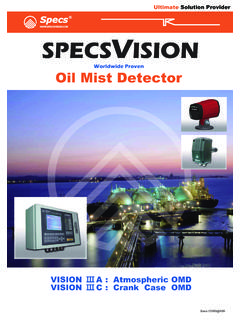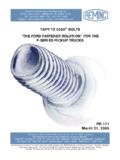Transcription of UCAR - Caiber S.A
1 UCAR USolutionVinyl ResinsforCoatingsContentsIMPORTANT:Union Carbide Corporation has compiled the informationcontained herein from what it believes are authoritativesources and believes that it is accurate and factual as ofthe date printed. It is offered solely as a convenience to its customers and intended only as a guide concerning theproducts mentioned. Since the user s product formulation,specific use application, and conditions of use are beyondUnion Carbide s control, Union Carbide makes no warrantyor representation regarding the results that may beobtained by the user. It shall be the responsibility of theuser to determine the suitability of any products mentionedfor the user s specific application.
2 This information is not to be taken as a warranty or representation for which Union Carbide assumes legal responsibility nor as permissionto practice any patented invention without a , DRUG, OR COSMETICNo chemical should be used as or in a food, drug, or cosmetic, or in a product or process in which it may contacta food, drug, or cosmetic, until the user has determined thesafety and legality of the use. Since government regulationsand use conditions are subject to change, it is the user sresponsibility to determine that the information containedherein is appropriate and suitable under the current,applicable laws and chemicals of a toxic nature are discussed in this publi-cation.
3 Before using any of them, we urge you to contactthe supplier and obtain the Material Safety Data Sheet andother safety information so that you can take the necessarymeasures to protect the health and safety of your , FLEXOL, PROPASOL, UCAR, UCARMAG, andUNION CARBIDE are registered trademarks of Union 1980, 1983, 1988, 1990, 1992, 1994, 1996, 1998 Union Solution Vinyl Resins for Coatings|1 Typical Properties Table|2 Applications Table|4 General Characteristics Table|4 FDA Status|5 Vinyl Chloride/Vinyl Acetate Copolymers|6 Carboxyl-Modified Vinyl Chloride/Vinyl Acetate Copolymers|7 Epoxy-Modified Vinyl Chloride/Vinyl Acetate Copolymers|7 Hydroxyl-Modified Vinyl Chloride/Vinyl Acetate Copolymers|8 Hydrolyzed Resins|8 Directly-Polymerized Resins|8 UCARMAG 527 and 569 Resins|9 Solution Vinyl Resins for VOC-Compliant Coatings|9 solutions |9 Viscosity Behavior|19 Application Methods|20 Solution Preparation|20 Formulation of Clear Coatings|22 Plasticizers|22 Heat Stabilizers|22
4 Light Stabilizers|23 Formulation of Pigmented Coatings|24 Modification with Other Polymers|27 Compatibility|27 Reactive (Crosslinking) Systems|27 Adhesion|29 Where Not to Use Vinyl Coatings|29 Product Safety|31 Further Information|31 Emergency Service|32 Through advanced solution vinyl resin technology, Union Carbide has successfullyextended the 50 years of proven performanceof the vinyl chloride Solution Vinyl Resins are available in four generalcopolymer types: Vinyl Chloride/Vinyl Acetate Carboxyl-Modified Vinyl Chloride/Vinyl Acetate Epoxy-Modified Vinyl Chloride/Vinyl Acetate Hydroxyl-Modified Vinyl Chloride/Vinyl AcetateThese copolymers are available as powders and solutionsin a range of molecular weights and based on these resins are non-oxidizing and permanently flexible, and are characterized by theabsence of color, odor, and taste.
5 They are not attacked at normal temperatures by dilute alkalies or mineralacids, alcohols, greases, oils, or aliphatic have a low moisture-vapor transmission rate, loworder of water absorption, and are tough and molecular weight and the ratio of vinyl chloride to vinyl acetate affect the solubility and other physicalproperties of the resin. As the molecular weight (degree of polymerization) is increased, the solution viscosityincreases and the strength of the film increases. Vinylchloride contributes film strength and toughness, as wellas water and chemical resistance. Vinyl acetate improvessolubility and film properly pigmented, coatings based on vinyl chloride/acetate copolymers have excellent outdoor durability.
6 Hydroxyl-modification improves compatibilityand adhesion, and provides a site for modification permits formulation of coatingsthat will adhere to clean metal surfaces on air-dry. Epoxy modification provides the ability to crosslink withcarboxyl-modified vinyl resins to give an all-vinyl reactivesystem that yields thermoset-like characteristics, mostnotably improved toughness, enhanced physical properties, and superior chemical Solution Vinyl Resins, produced by a proprietarysolution polymerization process, offer several advantages:High PurityNo water-soluble suspending agents or surfactants areused in the manufacture; therefore, water resistance isoutstanding.
7 Additionally, the as-received vinyl chloridemonomer (VCM) content of dry vinyl powders is <10 ppb(parts per billion). In formulated coatings, the VCM level is below the detectable limit of Polymer Composition and NarrowMolecular Weight DistributionProvide predictable solution viscosities and batch-to-batchproduction in GelsEasily dissolved and low in gels and insoluble UCAR Solution Vinyl Resins are completely compatiblewith each other and many different types of dry by evaporation. Hydroxyl-modified vinyls can be cured by Solution Vinyl Resins for Coatings2 Polymer Composition % by WtVCl908686868381 VAc101414131617 Other 1a1a2aReactive FunctionalityType carboxylcarboxylcarboxyl% by Wt No.
8 101019 Hydroxyl Value Epoxy Equivalent Wt Inherent Viscosity Gravity Transition Temp. (Tg), C797272747270 Average Molecular Wt, Mn*44,00027,00022,00027,00019,00015,000 Solution Viscosityhat 25 C, cP1300j60020065010055 Typical Solution PropertiesSolids, % by Wt152025202530 MEK/Toluene67/3350/5033/6750/5025/7525/7 5 Viscosity at 25 C, cP250200175150250370 UCAR Solution Vinyl ResinsVYNS-3 VYHHVYHDVMCHVMCCVMCA(a) Maleic acid(b) Epoxy-containing monomer(c) Solution 40% resin in MEK/toluene, 3/2 by wt(d) Vinyl alcohol(e) Hydroxyalkyl acrylate( f ) Oxirane oxygen(g) On solids(h) 30% resin in MEK( j) 20% resin in MEK(k) Sulfonate-containing monomer* Referenced to polystyrene 1 Typical Properties of UCAR Solution Vinyl Resins382909081818182859444444139b,c6d6d 15e15e15e14a,e2 , 767659636659 1600g ,00027,00022,00033,00024,00015,00035,000 22,000 100040093027570720105040c20252030302020 50/5050/5050/5050/5025/7550/5050/5010003 50400171184340170500 UCARMAG BinderVERR-40 VAGHVAGDVAGFVAGCVROH5275694table 2 General Characteristics of UCAR Solution Vinyl ResinsAppearance*White powderParticle Size% by wt, min, through 20 mesh98 Bulk Density, lb/ft324 to 34 Heat Loss, % by wt, Content, % by wt, Point.
9 C93 to 135*VERR-40 is a solutiontable 3 Applications & CharacteristicsApplicationsPackagingGene ral Marine &Magnetic StrippableWoodFoodNon-FoodMetalsMaintena nceMediaInksAdhesivesCoatingsFinishesVYN S-3 VYHH VYHD VMCH VMCC VMCA VERR-40 VAGH VAGD VAGF VAGC VROH UCARMAG Binder527 569 5 FDA RegulationUseUCAR Solution Vinyl Resin21 CFR of adhesives used in articles intended VYHD, VYHH, VYNS-3,for packaging, transporting or holding , VMCC, VMCH,VAGD, VAGH, VERR-4021 CFR of resinous and polymeric coatingsVYHD, VYHH, VYNS-3, to be applied as continuous films to food-contact VMCA, VMCC, VMCH,surfaces of articles intended for use in processing, VAGD, VAGH, VERR-40manufacturing, packing, producing, heating, packaging, holding, or transporting of a coating that is applied as a VYHD, VYHH, VYNS-3,continuous film over one or both sides of a baseVMCA, VMCC, VMCH,film produced from one or more of the basic olefinVAGD, VAGH polymers complying with of the food-contact surface of paper VYHD, VYHH, VYNS-3,and paperboard used to package aqueous andVMCA, VMCC, VMCH,fatty , VAGH21 CFR of paper and paperboard in contact VYHD, VYHH, VYNS-3,with dry , VMCC, VMCH,VAGD, VAGH, VERR-4021 CFR of closures with sealing gaskets VYHD.
10 VYHH, VYNS-3,for food , VMCC, VMCH,VAGD, VAGH, VERR-40(1) Since government regulations are subject to revision, it is the user s responsibility to refer to the Code of Federal Regulations or the Federal Register to determine current regulatory UCAR Solution Vinyl Resins listed below are cited in the following regulations1of the United States Food and DrugAdministration (FDA) for use in food-contact applications, suchas can, paper, film, and foil coatings, and coatings for StatusVinyl Chloride/Vinyl Acetate CopolymersVYNS-3 The highest molecular weight solution vinyl resin, havinga composition of approximately 90 percent vinyl chlorideand 10 percent vinyl acetate.








